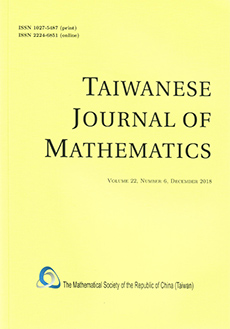Abstract
An analysis of connectivity reliability in daisy chain computer networks led to a combinatorial problem that is most easily described in terms of necklaces. Basically n beads, some black and some white, are to be arranged into a necklace. The problem is to nd the arrangements that satisfy some constraints on the separations between black beads. Thus, no black beads may be allowed to be adjacent and the number of black beads with s beads between them may be specied. Hwang and Wright gave a matrix method of counting those necklaces. Here we use generating functions for similar counts, but with an added condition that all s separating beads must be white. To reduce the set of arrangements to more manageable size we also count necklaces when two that dier only by a rotation are considered the same.
Citation
E. N. Gilbert. F. K. Hwang. "CONSTRAINED ARRANGEMENTS OF OBJECTS IN A CYCLE." Taiwanese J. Math. 1 (4) 361 - 370, 1997. https://doi.org/10.11650/twjm/1500406116
Information





